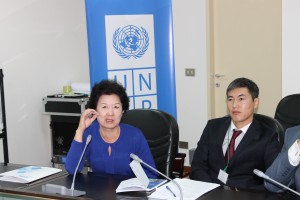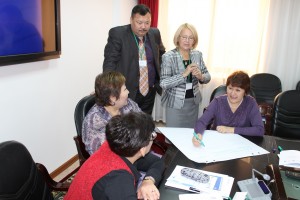 ASTANA – There is still a lot of work to be done in getting Kazakhstan’s mediation services up to par. The United Nations Development Programme (UNDP) and the Kazakh government have introduced a mediation system in the courts and it is already having a visible impact on the country, Gulmira Tulesbayeva, the project manager, told The Astana Times.
ASTANA – There is still a lot of work to be done in getting Kazakhstan’s mediation services up to par. The United Nations Development Programme (UNDP) and the Kazakh government have introduced a mediation system in the courts and it is already having a visible impact on the country, Gulmira Tulesbayeva, the project manager, told The Astana Times.
What are the terms and objectives of the project?
The project officially started in January 2012 and will last until December 2014. The project was initiated by the UNDP and the Supreme Court, which is the project’s official partner. The $400,000 project is funded by an associated grant between the Supreme Court of Kazakhstan and the UNDP. Other partners of the project are professional mediation organisations in Kazakhstan, the Academy of Public Administration, the prosecutors’ office, the American Bar Association and the Samruk Kazyna Centre for Social Partnership Fund and Mediation.
The project is part of the UNDP strategic goal to expand citizen access, including that of the socially disadvantaged, to justice and to ensure civil and human rights, as well as to assist the Kazakh government in implementing the Law on Mediation, adopted in 2011.
The project entails the studying of the world’s best mediation and mediation training techniques, suggesting legislative reforms, holding training modules for professional and non-professional mediators, training mediators outside of the city centres, as well as conducting outreach campaigns on public awareness about the benefits of using mediation as an effective way to solve disputes without tangible financial costs, while saving time and preserving relations between conflicting parties.
Can you provide an example of the best practices applied?
A study tour to Singapore was organised for professional mediators in 2012 by the UNDP. Singapore was chosen because of its exemplary use of alternative methods of dispute resolution, including mediation and a strong mediation culture. There is no law on mediation, but the practice of mediation is widely developed in settling almost all administrative and civil conflicts. There are specialised mediation centres for family matters, financial disputes, as well as individual centres to resolve disputes at the community (district) level. It should be noted that Singapore is a multiethnic and multicultural country and all mediation organisations try to select mediators that share commonalities in mentality with the involved parties.
Who is involved in the project?
The project involves international experts and national consultants represented by mediation organisations.
For example, Tatyana Dronzina, a renowned international expert in mediation, a professor of Granada University and the University of Sofia, analysed how mediators are trained in Kazakhstan. She was also actively involved in the development of mediation in Kazakhstan and has worked in Astana, Aktau and Kokshetau.
The Mediation Centre and the International Human Rights Centre were involved in the development of modular training programmes on mediation and holding regional training sessions. They are among the leading mediation centres in Kazakhstan. As a result of training, more than 200 mediators and 53 coach mediators were trained, which helped create a corps of professional mediators in Kazakhstan with the presence of mediators in each area.
Do you train organisations in mediation as well?
The UNDP project trains members of regional courts, the General Prosecutor’s Office and Ministry of Internal Affairs staff in the theory and practice of mediation in criminal and civil trials. Leading business coaches from the Kazakhstan Mediation Centre, experts from the U.S. and Germany, together with the American Bar Association and the German Society for International Cooperation (GIZ) provided the training. It is noteworthy that judicial and law enforcement agencies understand the importance of mediation and reconciliation procedures in reducing the workload of judges and the level of conflict and social tension.
The Kazakhstan General Prosecutor’s Office, along with the Supreme Court, Ministry of Justice, UNDP and other international organisations held a conference on developing a draft concept of “Reconciliation [in criminal and civil proceedings]” in June 2013, which is being finalised and will be submitted to the government. This will allow for legislation expanding opportunities for mediation procedures and other non-judicial mechanisms on resolving legal conflicts and improving extrajudicial dispute resolution to be introduced. The document combined basic advanced ideas in this area, including those based on the experience of foreign countries. The main objective of the concept is to reduce the number of criminal and civil cases under court consideration by at least 30 percent by 2017 through the development of reconciliation instruments. In order to achieve these results, a number of legislative changes will be needed, such as the use of settlement agreements at trial, expansion of the categories of disputes subject to mandatory pre-trial settlement.
Are there different types of mediation?
Extrajudicial mediation and mediation in the judicial process is used mainly for civil disputes (family, community, property and divorce issues). The use of mediation in relatively small criminal cases is also possible. Under the current law “On Mediation,” mediation is not applied to resolving a dispute if one of the parties involved is the state. As in most countries, in Kazakhstan, divorce cases and family conflict matters are turned over to mediators. In addition, juvenile courts transfer most cases to mediators.
Can you provide some statistical information on mediation cases?
Since the mediation procedure is confidential, statistics on disputes resolved by extrajudicial mediation are not kept. However, the General Prosecutor’s Office of Kazakhstan, which is the main developer of the draft bill “Reconciliation [in criminal and civil proceedings]” has begun keeping statistical records of court cases and of pre-trial law enforcement investigations terminated due to successful mediation.
According to the analysis of mediation development in Kazakhstan conducted in our project by the International Human Rights Centre, courts saw 123 civil disputes weighed by mediators in 2012. In the first half of 2013, 477 such cases were claimed, 458 of which were settled by the mediation procedure.
At the same time, statistical analysis of the Supreme Court shows that in 2013, in comparison to 2012, the number of civil cases settled through mediation increased 10-fold (from 122 to 1,276 cases.) The number of cases settled with settlement agreement decreased by 4 percent (from 9,730 to 9,335 cases). These findings suggest that the courts have not sufficiently taken steps to reconcile with the involved parties. The greatest number of cases settled through mediation is observed in the Kostanay (326), South Kazakhstan (176), Atyrau (165), East Kazakhstan (122) regional courts. The smallest number of such cases is in the courts of Almaty (6), Pavlodar (4) and North Kazakhstan (1) regions.
What are the major problems faced by the project?
Lack of public knowledge about mediation and its benefits is and always has been a major issue. Since the beginning of the project, information campaigns in Astana and Almaty, Atyrau and Shymkent were carried out through roundtables with representatives of local state bodies, judiciary, law enforcement and professional mediators. Representatives of regional organisations of mediators in Astana, Almaty, Uralsk and Kokshetau got mini-grants to conduct awareness campaigns and create informational materials on mediation in their regions.
Since mediation is based on the study of the source of the conflict, possessing mediation skills and techniques is largely encouraged, not only from a professional point of view, but also in terms of social relations. Therefore, in a society, much is spoken about the need to instill a culture of mediation from childhood that will help us raise a new generation with an already acquired culture of mediation that will help them further develop harmoniously and realise themselves in life.
What are the plans of the project?
Further plans include training mediators outside of the city centres, including in rural areas, training professional and non-professional mediators, conducting research to improve the standards of training of mediators, studying international experience on the introduction of the position of judge-mediator in the courts, as well an extensive media campaign to increase the awareness of how mediation can be used as an alternative method for solving legal disputes that saves time and money and keeps decent relations between parties that, in general, contribute to the overall improvement of relations in society. The main problem is building public confidence in these mediators. Mediators must do more to reach out to the general public in hopes of informing the masses. At the same time, they need government support in terms of legislative changes regarding the use of mediation in the judicial process and in assuring that they are paid for their services, particularly when assisting the socially vulnerable.


